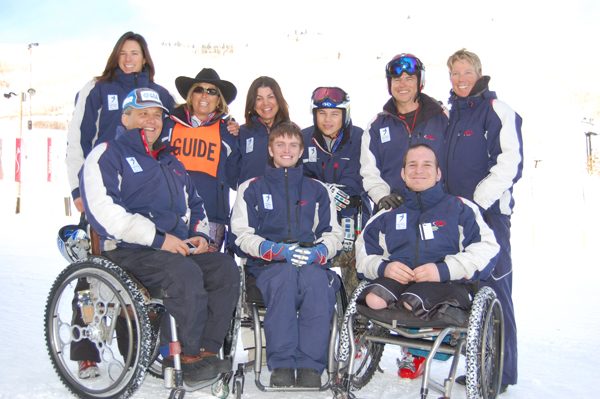Utah’s National Ability Center is the place for recreation and sports for people with disabilities.
The sun is rising over The Canyons, and the endless Utah sky is flecked with pink. We are the only ones on the mountain—the lucky group of first tracks skiers. Chris Waddell, Paralympic gold medalist, is leading the way. He double-checks his straps, making sure he’s safely secured in the custom sled, and begins his descent into the mouth of the black diamond.
He is beautiful to watch, carving S’s into perfect corduroy snow with three skis—one centered beneath his sled and one for each arm. The rest of us struggle to keep up, and are reminded that even with our fully-able bodies, we will never be as fast as him.
At the bottom, Waddell lets out an excited, “Whoo hoo!” and beams his famous smile—a smile that helped get him named one of People magazine’s 50 most beautiful people. It is this same excitement that he brings to the slopes every day. Waddell is an ambassador to The Canyons resort, a Paralympic athlete and a board member for the National Ability Center.
The National Ability Center (NAC) is located on a snow-covered 26-acre ranch just outside of Park City, Utah. Cross-country ski trails snake through the landscape and the giant Utah ski resorts are just a snowball’s throw away. Serving both competitive athletes like Waddell, as well as any individual with a disability who wants to participate in sports, the NAC is a mecca for modified sports and recreation.
With 25 different activities, ranging from sled-hockey teams (paraplegic ice hockey—think Murderball on ice) to rock climbing clinics, the NAC has sports for everyone’s interest and ability. “Pretty much any sport you can think of, we do,” says Jennifer Atkin, Special Events Manager of the NAC.
Founded in 1985 by Meeche White, the wife of a Vietnam vet who lost his leg in battle, the NAC’s guiding principle is that “recreation is as vital to the lives of people with disabilities as it is to people without disabilities.” The NAC believes that participation in sports creates confidence and a sense of empowerment, which carries over into all aspects of an individual’s life. The center’s motto is, “If I can do this, I can do anything.”
But the NAC is not just about serving those with disabilities; it’s also about serving their families. Often, families either forgo their adventure vacations because they can’t bring their child with a disability, or they leave their child at home. The NAC integrates the whole family into lessons so they can participate in sports together. “It’s a great experience for everyone,” says Atkin.
One of the most popular NAC experiences involves riding horses. But you might not see people sitting straight up, galloping into the sunset. Instead, individuals are riding bareback, laying down, draped over the side or even standing up on the gentle horses. All of this is part of a unique program called hippotherapy (hippo is Greek for horse).
“Horses have a way of understanding the participant,” says Jessica Kunzer, the former PR director for the NAC. She adds that sometimes an individual who doesn’t connect with other people will connect with animals.
Many of the horses are specifically trained to work with those with neuromuscular disorders. “When you sit on a horse, your body mimics the horse’s gait and retains the muscles,” says Atkin. She says this mimicry creates muscle memory in the body and can actually lead people to learn to walk or overcome their disabilities.
The NAC has gained international attention for its programs and cutting-edge facility, but the founders have remained true to their initial goal of “providing affordable sports and recreation activities.” Lodging at the NAC costs just $65 per double room, per night—a far cry from the typical Park City costs.
Atkin adds that the NAC has “a huge scholarship program” to make the services available to anyone who wants to participate. The number of participants is growing every year—in the first year, they offered 45 ski lessons. Today, more than 26,000 lessons are offered in the myriad of activities.
Recently, the NAC paired up with the U.S. Paralympics, a division of the Olympic Committee, to help athletes pursue their dreams of becoming the next Chris Waddell, who has medals in both skiing and track and field. Waddell is training to climb Mount Kilimanjaro, the tallest mountain in Africa. Using a hand-cycle, Waddell will power himself up the steep slopes, proving, as he says, “that being a ‘para’ doesn’t mean living a disabled life.”
At the bottom of the slope, Waddell and I load onto the lift. I struggle to get my new skis off in time for the gondola’s arrival; Waddell is patiently waiting. By now, the sun has fully risen and we gaze out the gondola window at the extraordinary scene of blue sky and fresh powder. “This changes people’s lives,” he says. He smiles. I smile. And we get ready to ski it again.
To read about the growing number of women’s ski and snowboard camps in Park City and Salt Lake City, Utah, check out our travel feature, "Sisterhood on the Mountain." Need hot new duds to wear on your ski vacation? Read our guide to edgy women’s outdoor wear, "Hot Gear for Cool Weather". Ready to make the switch from two planks to one? Find out how one woman is singlehandedly raising the bar on snowboard design with boards made specifically for women in "Ride Like a Girl"
